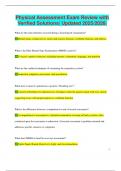Physical Assessment Exam Review with
Verified Solutions| Updated 2025/2026|
What are the main elements assessed during a neurological examination?
Mental status, cranial nerves, motor and sensory function, cerebellar function, and reflexes
What is the Mini-Mental State Examination (MMSE) used for?
To assess cognitive function, including memory, orientation, language, and attention
What are the cardinal techniques of examining the respiratory system?
Inspection, palpation, percussion, and auscultation
What does it mean if a patient has a positive "Romberg test"?
A positive Romberg test indicates loss of balance when the patient stands with eyes closed,
suggesting issues with proprioception or vestibular function
What is the difference between a comprehensive and a focused assessment?
A comprehensive assessment is a detailed examination covering all body systems, often
conducted upon first encounter or admission. A focused assessment is problem-oriented and
addresses specific concerns or symptoms.
What does PERRLA stand for in an eye assessment?
Pupils Equal, Round, Reactive to Light, and Accommodation
1
,What is the primary purpose of palpation in a physical assessment?
To assess the texture, temperature, moisture, organ location and size, as well as any lumps or
areas of tenderness
What is the purpose of auscultation in physical examination?
To listen to body sounds, particularly those of the heart, lungs, and abdomen, for assessing
normal and abnormal sounds
What are the four main techniques used in a physical examination?
Inspection, palpation, percussion, and auscultation
What is the purpose of obtaining a health history?
To collect subjective data on the patient’s past and present health, helping to inform diagnosis
and care planning
What is the difference between a sign and a symptom?
A sign is an objective finding observed by the examiner, while a symptom is subjective and
reported by the patient.
What is orthostatic hypotension, and how is it assessed?
A drop in blood pressure upon standing, typically assessed by measuring blood pressure in
supine, sitting, and standing positions.
2
,What is the purpose of percussion in physical examination?
To assess underlying structures by tapping on the body, providing information about the
density, size, and position of organs.
What does SOAP stand for in clinical documentation?
Subjective, Objective, Assessment, and Plan
What does the term "baseline data" refer to in physical assessment?
Baseline data refers to initial information gathered on a patient’s health status, used as a
comparison for future assessments.
What are the characteristics of effective communication during a patient interview?
Active listening, empathy, open-ended questions, and maintaining a respectful and
nonjudgmental approach
What are the elements of a general survey in physical assessment?
Physical appearance, body structure, mobility, and behavior
What does BMI measure, and what does it indicate?
Body Mass Index measures body fat based on height and weight, indicating underweight,
normal, overweight, or obesity status.
3
, What does the term "chief complaint" refer to?
The primary reason the patient is seeking medical care, often documented in the patient’s own
words
What does an elevated jugular venous pressure indicate?
It may indicate right-sided heart failure or fluid overload.
What is the purpose of functional assessment in physical examination?
To evaluate the patient's ability to perform activities of daily living (ADLs) and instrumental
activities of daily living (IADLs).
What are adventitious breath sounds?
Abnormal sounds heard in the lungs, such as crackles, wheezes, or rhonchi, which may
indicate respiratory issues.
What does the term "clinical reasoning" mean in a healthcare context?
The process of gathering, analyzing, and interpreting data to make informed clinical
decisions.
What are the characteristics of a good patient history?
Comprehensive, accurate, relevant, and organized information reflecting both subjective and
objective data.
4




